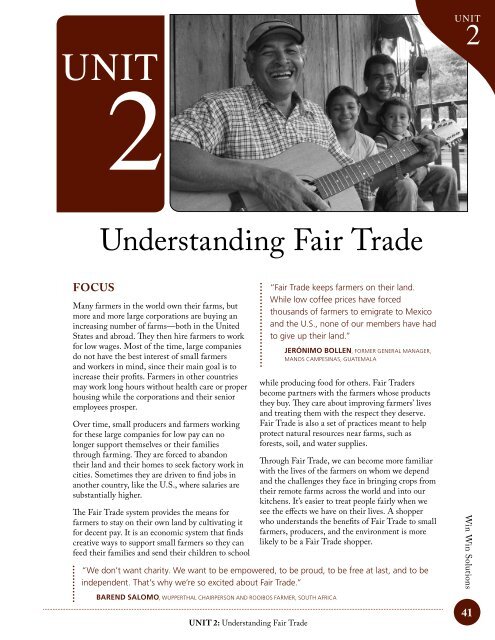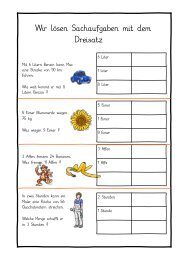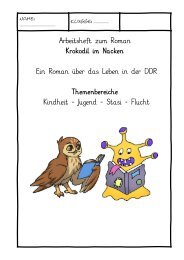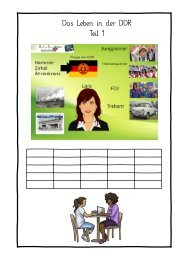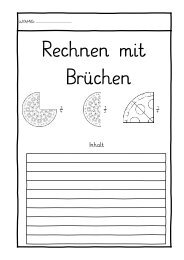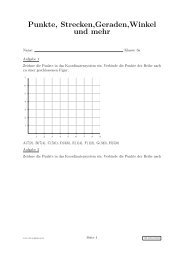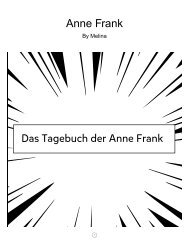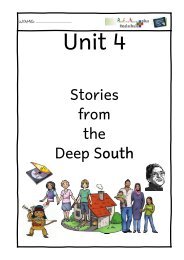Create successful ePaper yourself
Turn your PDF publications into a flip-book with our unique Google optimized e-Paper software.
UNIT<br />
2<br />
UNIT<br />
2<br />
Understanding Fair Trade<br />
Focus<br />
Many farmers in the world own their farms, but<br />
more and more large corporations are buying an<br />
increasing number of farms—both in the United<br />
States and abroad. They then hire farmers to work<br />
for low wages. Most of the time, large companies<br />
do not have the best interest of small farmers<br />
and workers in mind, since their main goal is to<br />
increase their profits. Farmers in other countries<br />
may work long hours without health care or proper<br />
housing while the corporations and their senior<br />
employees prosper.<br />
Over time, small producers and farmers working<br />
for these large companies for low pay can no<br />
longer support themselves or their families<br />
through farming. They are forced to abandon<br />
their land and their homes to seek factory work in<br />
cities. Sometimes they are driven to find jobs in<br />
another country, like the U.S., where salaries are<br />
substantially higher.<br />
The Fair Trade system provides the means for<br />
farmers to stay on their own land by cultivating it<br />
for decent pay. It is an economic system that finds<br />
creative ways to support small farmers so they can<br />
feed their families and send their children to school<br />
“Fair Trade keeps farmers on their land.<br />
While low coffee prices have forced<br />
thousands of farmers to emigrate to Mexico<br />
and the U.S., none of our members have had<br />
to give up their land.”<br />
Jerónimo Bollen, former General Manager,<br />
Manos Campesinas, Guatemala<br />
while producing food for others. Fair Traders<br />
become partners with the farmers whose products<br />
they buy. They care about improving farmers’ lives<br />
and treating them with the respect they deserve.<br />
Fair Trade is also a set of practices meant to help<br />
protect natural resources near farms, such as<br />
forests, soil, and water supplies.<br />
Through Fair Trade, we can become more familiar<br />
with the lives of the farmers on whom we depend<br />
and the challenges they face in bringing crops from<br />
their remote farms across the world and into our<br />
kitchens. It’s easier to treat people <strong>fair</strong>ly when we<br />
see the effects we have on their lives. A shopper<br />
who understands the benefits of Fair Trade to small<br />
farmers, producers, and the environment is more<br />
likely to be a Fair Trade shopper.<br />
“We don’t want charity. We want to be empowered, to be proud, to be free at last, and to be<br />
independent. That’s why we’re so excited about Fair Trade.”<br />
Win Win Solutions<br />
Barend Salomo, Wupperthal Chairperson and rooibos farmer, South Africa<br />
UNIT 2: Understanding Fair Trade<br />
41
UNIT 2: Understanding Fair Trade<br />
Summary of Classroom Activities<br />
In this unit students learn about Fair Trade and find out how they can support it.<br />
CLASS #1: Hard Work<br />
Students analyze the assumption, “If you work hard, you’ll make a lot of money.” They read about the lives<br />
of cocoa farmers and find out that sometimes people work hard but don’t make a lot of money.<br />
CLASS #2: What’s Fair Game<br />
Students get to be cocoa farming families and the buyers and bankers involved in the system. They<br />
experience first-hand the difficulties of making a living growing cocoa and learn how Fair Trade can<br />
make a significant difference.<br />
CLASS #3: A Day in the Life<br />
Students learn about a morning routine for one cocoa farmer’s child.<br />
CLASS #4: Jigsaw<br />
Students work cooperatively in five groups to become “experts” on the information their group has on Fair<br />
Trade. They then share this information with the rest of the class.<br />
CLASS #5: Fair Trade Mural<br />
Students create a mural to show how products get from remote small farms to their homes.<br />
CLASS #6: The Farmer’s Ballad<br />
Have a local farmer come in and talk about what s/he plants and how s/he sells the things s/he grows.<br />
Students write a ballad about the farmer’s life.<br />
42<br />
UNIT 2: Understanding Fair Trade
UNIT 2: Understanding Fair Trade<br />
Background on Fair Trade<br />
Many people aren’t aware that the prices for edible commodities such as raw cocoa beans fluctuate<br />
drastically from day to day, even from hour to hour. That’s because the goods are sold on international<br />
commodities markets, where a host of factors, such as world supply and demand, determine the current<br />
price. Traders are out to make as much money as they can on these commodities, and when they<br />
determine the prices, they do not consider how much it cost the farmers to make the goods. As a result,<br />
the amount of money that farmers get for their hard work often does not cover their production costs.<br />
In addition, small-scale farmers living in remote villages don’t have access to the technology that would<br />
inform them of the latest commodities prices. They accept what middlemen tell them and end up without<br />
enough money to clean up their drinking water, pay for books and uniforms for school, or improve their<br />
farms.<br />
Fair Trade was created to stabilize the prices that international farmers get so they know<br />
what kind of income to expect. Fair Trade prices also aim to cover farmers’ real expenses<br />
and daily needs; the prices, therefore, are usually higher than the going market rates.<br />
Coffee was the first commodity sold under Fair Trade principles, and the strategy began<br />
in Europe in the 1960s. Since then, it has turned into an international movement with<br />
thousands of participating businesses and co-ops, and millions of consumers who make<br />
choices based on its standards.<br />
For more than 20 years, Equal Exchange has been a significant player in U.S. Fair Trade movement. We<br />
share our story often because we believe it exemplifies the kind of vision, determination, and cooperation<br />
that’s necessary to make Fair Trade work.<br />
The Equal Exchange<br />
Story<br />
A Vision<br />
The three founders of Equal Exchange–Rink<br />
Dickinson, Michael Rozyne, and Jonathan<br />
Rosenthal–all had farmers in the forefront of their<br />
minds when they started the company in 1986.<br />
Rink, Michael, and Jonathan left their jobs and<br />
invested their own money to create a company<br />
with a vision of <strong>fair</strong>ness for farmers. A core group<br />
of friends and family provided $100,000 needed<br />
to start the new endeavor, and after three years of<br />
discussion, the three created a plan for the new<br />
organization. Equal Exchange would be:<br />
* A social change organization that would help<br />
farmers and their families gain more control over<br />
their economic futures.<br />
* A group that would educate consumers about<br />
<strong>trade</strong> issues affecting farmers.<br />
* A provider of high-quality foods that would<br />
nourish the body and the soul.<br />
* A company that would be controlled by the<br />
people who did the actual work.<br />
* A community of dedicated individuals who<br />
believed that honesty, respect, and mutual benefit<br />
are integral to any worthwhile endeavor.<br />
They chose Nicaraguan coffee as the first Equal<br />
Exchange product for a few reasons. In 1986, the<br />
Reagan administration imposed an embargo on all<br />
products from Nicaragua’s Sandinista government.<br />
Importing coffee beans from Nicaragua would<br />
demonstrate solidarity with the growing people’s<br />
movement there and would challenge U.S. <strong>trade</strong><br />
policies. Equal Exchange brought Nicaraguan<br />
coffee into the U.S. through a loophole in the law.<br />
If the coffee was roasted in another country, it<br />
could be regarded as a product from that country,<br />
and was therefore legal in the United States. A<br />
friendly Dutch alternative <strong>trade</strong> company stepped<br />
forward to roast it.<br />
Alerted to this symbolic action, the Reagan<br />
administration tried to stop the tiny organization.<br />
Officials seized Equal Exchange’s Nicaraguan<br />
coffee as soon as it arrived in the port of Boston.<br />
During their first two years of business, the<br />
founders spent many days with lawyers battling<br />
Win Win Solutions<br />
UNIT 2: Understanding Fair Trade<br />
43
UNIT 2: Understanding Fair Trade<br />
customs officials. Each time the coffee cargo was<br />
released, it was a small victory. After two years it<br />
became clear that Equal Exchange wasn’t going<br />
away. Now attention could be focused on building<br />
this alternative business.<br />
Farmer Partners<br />
In those early<br />
years, the<br />
founders spent<br />
much of their<br />
time trying<br />
to identify<br />
democratically<br />
run farmer<br />
groups,<br />
understand the internal structure of farmer co-ops,<br />
and determine product quality. Slowly but steadily,<br />
Equal Exchange located farmer groups and added<br />
coffees from cooperatives in Latin America and<br />
Africa. By 1991, Equal Exchange had become part<br />
of the European Fair Trade network, aligning with<br />
groups that were at least a decade ahead of what<br />
was happening in the U.S.<br />
Tea seemed like an appropriate next step. First,<br />
it was a commodity consumed by millions, and<br />
second, it was a natural complement to coffee.<br />
The founders were already in close contact with<br />
representatives from a village movement in Sri<br />
Lanka, and by 1987, Equal Exchange brought in<br />
its first high-quality black tea.<br />
Around 1991, Equal Exchange established itself<br />
as a Fair Trade specialty coffee company. By 1994,<br />
Equal Exchange had become a worker-owned<br />
cooperative with 20 members. Another exciting<br />
benchmark was 1996, when Equal Exchange joined<br />
with Lutheran World Relief in a ground-breaking<br />
collaboration to launch what has now become<br />
our Interfaith Program. This major initiative<br />
helped Equal Exchange create partnerships with<br />
communities of faith throughout the U.S. Today,<br />
the company partners with eight different faithbased<br />
organizations: American Friends Service<br />
Committee, Church of the Brethren, Lutheran<br />
World Relief, Mennonite Central Committee,<br />
Presbyterian Church USA, Unitarian Universalist<br />
Service Committee, United Church of Christ, and<br />
United Methodist Committee on Relief.<br />
Not wanting to stop there, Equal Exchange<br />
created a hot cocoa mix in 2001, which helped<br />
the company reach out to a different group of<br />
farmers and provide options for consumers who<br />
want to be certain that their cocoa is not being<br />
harvested by slave or child labor. The next logical<br />
step was to introduce Fair Trade chocolate bars,<br />
which happened in 2004. This required sourcing<br />
ingredients from many places around the world.<br />
20-plus Years and Counting<br />
Today, Equal Exchange is a<br />
thriving model of Fair Trade. Equal<br />
Exchange offers coffee, tea, and<br />
chocolate products from 38 farmer<br />
cooperatives in 20 countries. With<br />
more than 70 worker-owners in the<br />
U.S., a broader network that includes<br />
400 loyal investors, more than 300<br />
food cooperatives, hundreds of cafés and other<br />
stores, and more than a million consumers, Equal<br />
Exchange exists despite the odds.<br />
Over the next few decades, Equal Exchange will<br />
continue to collaborate with like-minded partners<br />
and stakeholders throughout the Fair Trade system<br />
to transform how business is done. Its vision<br />
includes the idea of bringing Fair Trade home by<br />
fostering direct relationships with family farmers<br />
here in the U.S. Collective achievements of the<br />
past 20 years prove that together folks can create<br />
change beyond their wildest dreams.<br />
44<br />
UNIT 2: Understanding Fair Trade
UNIT 2: UNDERSTANDING FAIR TRADE<br />
1<br />
CLASS<br />
Hard Work<br />
Materials Needed<br />
Five cards, each with a picture and accompanying information representing the five steps of cocoa<br />
farming.<br />
Classroom Narrative<br />
DIALOGUE: Tell me if you agree or disagree with the statement, “If you work hard, you’ll make a lot<br />
of money.” Can you think of examples of people who work hard and make a lot of money? Can you think<br />
of examples of people who work hard and don’t make a lot of money? When might this statement be true<br />
and when might it not be true?<br />
How would you feel if someone paid you very little for something that took you a long time to<br />
make? How would you feel if the product that you helped to make cost more than what you were paid for<br />
in a week? A month?<br />
ACTIVITY: Tell students we’re going to look at what it takes to be a cocoa farmer. Have students look<br />
at the steps for growing cocoa by dividing the class into eight groups. Give each group an information<br />
card to study. Then call each group up, in order, to hold up the picture to the class. The rest of the class<br />
asks questions to find out more about the pictures which the representative group can answer. Begin with<br />
the picture showing the cocoa pods growing on the tree, then follow in order.<br />
UNIT 2: Understanding Fair Trade<br />
CLASS 1: Hard Work<br />
Win Win Solutions<br />
UNIT 2: Understanding Fair Trade • CLASS 1: Hard Work<br />
45
Hard Work<br />
Growing Cocoa<br />
Win Win Solutions<br />
UNIT 2: Understanding Fair Trade • CLASS 1: Hard Work<br />
000 47
Hard Work<br />
Growing Cocoa<br />
å<br />
COCOA<br />
Cocoa comes from the cocoa tree or Theobroma cacao (Theobroma<br />
actually means “food of the gods”). It is grown by over two million<br />
small producers who are mostly small farmers. These trees are not yet<br />
fully grown. It can take up to five years for a tree to produce cocoa pods,<br />
at which point a farmer can harvest the cocoa.<br />
ç<br />
THE COCOA TREE<br />
The tree is an evergreen and grows in about 50 tropical countries<br />
along the equator, such as the Dominican Republic, Peru, and some<br />
countries in West Africa. The tree can grow up to 30 feet but is<br />
normally trimmed to make harvesting easier for the farmers. A tree<br />
can continue to produce pods year round until it is 25 or 30 years old.<br />
000 48<br />
UNIT 2: Understanding Fair Trade • CLASS 1: Hard Work
Hard Work<br />
Growing Cocoa<br />
Win Win Solutions<br />
UNIT 2: Understanding Fair Trade • CLASS 1: Hard Work<br />
49
Hard Work<br />
Growing Cocoa<br />
é<br />
THE COCOA POD<br />
Every year a cocoa tree grows thousands of flowers on its trunk and<br />
branches. Only a small percentage, as low as 1%, of these flowers<br />
will actually produce a cocoa pod. The cocoa pod, which is the fruit<br />
from the tree, can be similar to the size and shape of a football.<br />
It grows out of the trunk and branches of the tree. Cocoa pods<br />
begin to ripen in five to six months and once they are ripe they are<br />
harvested carefully by hand, often with the help of a machete.<br />
è<br />
HARVESTING<br />
When ripe, the pods are cut down from the trees, typically using<br />
machetes or knives on long poles. They are cut with care so that<br />
the stalks are not damaged. Though pods can be harvested year<br />
round, there are typically two major harvest times, called “Main”<br />
and “Mid.” In the Dominican Republic the Main harvest typically<br />
occurs from April to July and the Mid harvest occurs from October<br />
to January.<br />
50<br />
UNIT 2: Understanding Fair Trade • CLASS 1: Hard Work
Hard Work<br />
Growing Cocoa<br />
Win Win Solutions<br />
UNIT 2: Understanding Fair Trade • CLASS 1: Hard Work<br />
51
Hard Work<br />
Growing Cocoa<br />
ê<br />
THE COCOA BEAN<br />
Each pod contains beans surrounded by a sweet pulp, which<br />
attract animals (and humans, too, since it’s so tasty!). Pods are<br />
cracked open, often with a machete or wooden club, to remove<br />
the beans, surrounded by white pulp. There are roughly 30-50<br />
beans in a typical pod and these beans are what ultimately get<br />
transformed into cocoa powder or chocolate.<br />
ë<br />
FERMENTATION<br />
Once the pods are harvested, they are cracked open. For a higher<br />
quality bean, the beans are fermented (they undergo a chemical<br />
conversion) to remove the pulp, to stop the bean from germinating,<br />
and to begin flavor development.<br />
52<br />
UNIT 2: Understanding Fair Trade • CLASS 1: Hard Work
Hard Work<br />
Growing Cocoa<br />
Win Win Solutions<br />
UNIT 2: Understanding Fair Trade • CLASS 1: Hard Work<br />
53
Hard Work<br />
Growing Cocoa<br />
í<br />
DRYING<br />
After fermentation the beans are dried. Cocoa beans are often<br />
dried in the sun, which can happen on tarps, mats, or raised flat<br />
surfaces, and they are raked so that they will dry more evenly.<br />
The drying process can take up to a week. If the beans are dried<br />
too long they will become brittle, and if they’re not dried long<br />
enough they run the risk of becoming moldy. Once dried, cocoa<br />
beans can be stored for four to five years.<br />
ì<br />
CHOCOLATE<br />
The chocolate company uses the beans to make chocolate bars.<br />
54<br />
UNIT 2: Understanding Fair Trade • CLASS 1: Hard Work
CLASS2<br />
UNIT 2: UNDERSTANDING FAIR TRADE<br />
What’s Fair Game<br />
Adapted from a lesson by Global Connections.<br />
Materials Needed<br />
Cocoa beans (if available), an Equal Exchange<br />
chocolate bar, a lot of scrap paper, scissors, five<br />
calculators (one for each group), a copy of the<br />
“What’s Fair Game Cards” cut up, five copies<br />
of the “What’s Fair Group Accounting Record,”<br />
and a copy of the “Buyer and Banker Instructions”<br />
cut up.<br />
Classroom Narrative<br />
WARM UP: You are going to be cocoa farmers.<br />
Do you like chocolate? What is your favorite<br />
kind of chocolate? What chocolate is made from?<br />
(Have an Equal Exchange chocolate bar nearby<br />
so students can read the ingredients if they don’t<br />
know them: milk, cocoa beans and sugar.) Where<br />
do these ingredients come from? (Milk comes<br />
from all over the world. Cocoa beans and sugar are<br />
grown in Africa, and South and Central America,<br />
where it’s hot.)<br />
We’re going to learn a little bit about what it’s like<br />
to be cocoa farmers in the Dominican Republic.<br />
ACTIVITY: Ask students to find the Dominican<br />
Republic on a world map and imagine what the<br />
weather is like there.<br />
Divide the class into five groups of farmers. Tell<br />
them they are going to pretend they are all farmers<br />
growing cocoa beans. Tell them Group #5 is a<br />
farmer cooperative called CONACADO which<br />
sells its beans to Equal Exchange, a Fair Trade<br />
cooperative. The others are traditional cocoa<br />
farmers.<br />
If cocoa beans are available, pass them around to<br />
each group and ask them to examine the beans.<br />
DIALOGUE: What do you notice about the<br />
beans? How do they feel? What do they smell like?<br />
Did you know chocolate is made from cocoa beans?<br />
ACTIVITY: Give each group a stack of scrap<br />
paper and scissors. Explain they will be drawing<br />
cocoa beans on the paper and cutting them out<br />
instead of really growing them. Encourage them to<br />
draw simple outlines of cocoa beans because speed<br />
is important in cocoa production. Tell them their<br />
job is to work together to draw and cut out as many<br />
beans as possible in one minute. Show them an<br />
example of the kind of cocoa bean they are going<br />
to grow. Give each group a few minutes to discuss<br />
how they are going to get a good crop this year.<br />
TO PLAY:<br />
Give the groups exactly 60 seconds to draw and cut<br />
out cocoa beans. (You can give younger students<br />
more time if they are working slowly.) Ask each<br />
farmer group to count up the beans they have<br />
grown and write the total on their “What’s Fair<br />
Group Accounting Record.”<br />
Then give each group one good and one bad<br />
“What’s Fair Game Card.” Go around to each<br />
farmer group, asking one student from each<br />
group to read their cards out to the class. Give or<br />
take away beans as required and ask each group<br />
to record the number of beans they gained, the<br />
number they lost, and the number they’ve ended<br />
up with on their “What’s Fair Group Accounting<br />
Record.” Tell them their final total is the number<br />
of beans they have managed to grow this year.<br />
Explain that the currency in the Dominican<br />
Republic is the Dominican Republic peso, and that<br />
you are going to pretend the market price for cocoa<br />
is two pesos per cocoa bean.<br />
Tell the groups of farmers that they don’t have a<br />
bank account and that it would take them weeks<br />
and lots of traveling around to find a bank that<br />
would cash a check for them, so they should do<br />
what they can to get paid in cash.<br />
UNIT 2: Understanding Fair Trade<br />
CLASS 2: What’s Fair Game<br />
Win Win Solutions<br />
UNIT 2: Understanding Fair Trade • CLASS 2: What’s Fair Game<br />
55
UNIT 2: Understanding Fair Trade • CLASS 2: What’s Fair Game<br />
Choose five students to pretend they are Cocoa<br />
Buyers. Have each Buyer meet with their group<br />
one by one and act out the transaction described<br />
in the “Buyer Instructions” while the other groups<br />
watch. Have the farmer groups write down on<br />
their “What’s Fair Group Accounting Record” how<br />
much they earned for their beans.<br />
Then choose five students to pretend they are the<br />
Bankers for each group who have lent the farmers<br />
the money they needed to support their families<br />
and to grow their crops for the last year. Have<br />
each Banker meet with their group one by one and<br />
act out the transaction described in the “Banker<br />
Instructions” while the other groups watch. Have<br />
the farmer groups write down on their “What’s<br />
Fair Group Accounting Record” how much they<br />
paid in expenses last year and how much they<br />
earned at the end of the year after paying their<br />
expenses.<br />
Dialogue: Encourage students to reflect on<br />
what they experienced in the game. Ask them:<br />
How did it feel to play the roles they played?<br />
What was fun? What was hard?<br />
What did you notice about the growing<br />
season? About the buyers? About the<br />
bankers? About their Accounting Record?<br />
What role did luck play? What role did<br />
cooperation play?<br />
What did you learn about being a cocoa<br />
farmer? What might be fun? What might<br />
be hard? What felt <strong>fair</strong>? What didn’t?<br />
Wrap up by telling students:<br />
The world price for cocoa is often not high<br />
enough for farmers to live on. Sometimes<br />
farmers are paid even less than the market<br />
price because that’s what their buyers pay<br />
them. Sometimes farmers are cheated if they<br />
can’t read weighing scales, do math, or know<br />
if the buyer has tampered with the scale.<br />
Farmers are sometimes paid by check, even<br />
though they have no bank account. It can<br />
take weeks to cash the check. Sometimes<br />
farmers lose their land when they can’t get<br />
enough money for their crops. Fair Trade<br />
companies like Equal Exchange try to<br />
ensure that farmers have enough money to<br />
support their families, stay on their land,<br />
grow their crops in a way that is good for<br />
the environment, and strengthen their<br />
communities.<br />
What did you learn about Fair Trade? How<br />
did it help the farmers?<br />
Which farmer group would you want to be<br />
in?<br />
56<br />
UNIT 2: Understanding Fair Trade • CLASS 2: What’s Fair Game
✎ STUDENT ACTIV IT Y HANDOUT ✎<br />
NA ME:<br />
dATE:<br />
What’s Fair Group Accounting Record<br />
Group #<br />
Farmer Group Members:<br />
Number of cocoa beans harvested:<br />
Extra cocoa beans earned:<br />
Subtotal:<br />
Cocoa beans lost:<br />
Total beans harvested:<br />
Pesos we earned for the cocoa beans we grew:<br />
Pesos we paid to support our families and grow our crops:<br />
Pesos we earned after paying out expenses:<br />
Check one:<br />
This felt <strong>fair</strong> to us.<br />
This didn’t feel <strong>fair</strong> to us.<br />
UNIT 2: Understanding Fair Trade • CLASS 2: What’s Fair Game<br />
57
What’s Fair Game Cards<br />
Cut out these cards and give each group of farmers one good card and one bad card.<br />
GOOD CARDS<br />
The weather has been very good and your beans<br />
have grown well.<br />
Add 40 extra beans<br />
Your beans do not get any<br />
diseases this year.<br />
Add 30 extra beans<br />
You buy natural pesticides in bulk with other<br />
farmers and save money.<br />
Add 20 extra beans<br />
Your hoe breaks,<br />
but you mend it yourself.<br />
Add 10 extra beans<br />
You share tools with other farmers<br />
and save money.<br />
Add 20 extra beans<br />
Your beans do not get<br />
any diseases this year.<br />
Add 30 extra beans<br />
BAD CARDS<br />
A storm has destroyed<br />
half of your trees.<br />
Give back half your beans<br />
Your hoe breaks<br />
and you have to buy a new one<br />
because you can’t fix it.<br />
Give back 10 beans<br />
Your mother is ill. You have to borrow money<br />
to buy medicine.<br />
Give back 20 beans<br />
Your hoe breaks<br />
and you have to buy a new one<br />
because you can’t fix it.<br />
Give back 10 beans<br />
Your cocoa beans are drying on the racks and it<br />
rains. Some beans spoil.<br />
Give back one quarter of your beans<br />
Exception: If group 5 gets this card, they give nothing back<br />
because they have a drying barn to protect their crop.<br />
Some of your trees have caught a disease called<br />
black pod.<br />
Give back one fifth of your beans<br />
Win Win Solutions<br />
UNIT 2: Understanding Fair Trade • CLASS 2: What’s Fair Game<br />
59
What’s Fair<br />
Buyer & Banker Instructions<br />
Buyer Instructions<br />
Group 1 Pay two pesos per bean. Say you<br />
will pay them by check, but if they protest, pay<br />
them in cash. Be civil and efficient.<br />
Banker Instructions<br />
Group 1 Charge them one and a quarter<br />
times what they earned for their cocoa. Tell<br />
them they just owe you the rest. Assure them<br />
they can make up the difference during the<br />
next growing season.<br />
Group 2 Take the beans and put them<br />
in your desk or bag. Then pay one peso per<br />
bean in cash. Treat the farmers rudely. If they<br />
complain, just leave with their beans.<br />
Group 3 Pay two pesos per beans, but<br />
cheat them, paying for five less beans than<br />
they have. If they question you, be evasive<br />
and in a hurry. If they complain, tell them<br />
there aren’t any other buyers for 30 miles.<br />
Take it or leave it.<br />
Group 4 Pay them two pesos per bean but<br />
pay them with a check. If they complain, tell<br />
them there aren’t any other buyers for 30 miles.<br />
Take it or leave it.<br />
Group 5 Be very friendly. Tell them you<br />
are their Fair Trade Buyer and that you’re so<br />
glad to get a chance to come down and see<br />
them again. You just love coming down to<br />
visit the farmers in CONACADO, the cocoa<br />
farmer cooperative who sells to your company.<br />
Remind them that you agreed to pay them<br />
three pesos per bean or more if the market<br />
price is higher so that they can make a good<br />
living this year and grow their crops in a way<br />
that’s good for the environment. Check with<br />
them to see if they think three pesos per bean<br />
will be enough next year. If they need more,<br />
say you’ll talk with people at your company and<br />
come back to make a new agreement before<br />
the next growing season starts. Then happily<br />
pay them the three pesos per bean. Talk with<br />
each farmer about their families and about the<br />
school the cooperative members are going to<br />
build this year for their children.<br />
Group 2 Charge them three times what<br />
they earned for their cocoa. Tell them you are<br />
taking their farms to pay off their debts. They<br />
will need to find another place to live and other<br />
work to do starting this coming week. Treat<br />
them rudely.<br />
Group 3 Charge them two times what they<br />
earned for their cocoa. Tell them they owe you<br />
the rest. Tell them their debts are mounting<br />
and they may lose their farms if they don’t have<br />
a good year next year. Look for opportunities<br />
to cheat them. Don’t give them a straight<br />
answer on anything. Be evasive and in a hurry.<br />
Group 4 Charge them one and a half times<br />
what they earned for their cocoa. Tell them<br />
they must pay you immediately. Tell them you<br />
will not take their check. If they say they have<br />
no money until they cash your check, tell them<br />
they should not be in business if they cannot<br />
take care of their financial af<strong>fair</strong>s. Tell them<br />
you will take their farms if they don’t get you<br />
the money they owe you in the next couple<br />
days.<br />
Group 5 Charge them half of the money<br />
they earned for their cocoa. Congratulate<br />
them on how their cooperative really kept<br />
their expenses down last year. Tell them their<br />
application for the loan for their new school<br />
was approved and ask them if they are ready<br />
to pay a quarter of the money they have left to<br />
make the down payment on that loan to get<br />
construction started. Tell them your bank is<br />
very pleased that they were able to pay off their<br />
loan for the storage barn in only two years. Tell<br />
them it’s a pleasure doing business with them.<br />
Win Win Solutions<br />
UNIT 2: Understanding Fair Trade • CLASS 2: What’s Fair Game<br />
61
UNIT 2: UNDERSTANDING FAIR TRADE<br />
CLASS<br />
A Day in the Life3<br />
Materials Needed<br />
Student Activity Handouts<br />
Classroom Narrative<br />
ACTIVITY: Read the story about a typical morning of a child whose family is part of a Fair Trade cocoa<br />
farmer co-op in the Dominican Republic.<br />
DIALOGUE: How do your mornings compare with this child’s in the Dominican Republic? How are<br />
your lives different from the lives of children born into cocoa-growing families? What is appealing about<br />
their lives? What is appealing about yours? What might be hard about their lives? What’s hard about our<br />
lives here in the U.S.?<br />
ACTIVITY: Have students write about a typical morning in their lives and how it compares with this<br />
child’s in the Dominican Republic.<br />
Have students volunteer to read their essays out loud. Post selected essays on a bulletin board for everyone<br />
to see.<br />
UNIT 2: Understanding Fair Trade<br />
CLASS 3: A Day in the Life<br />
Win Win Solutions<br />
UNIT 2: Understanding Fair Trade • CLASS 3: A Day in the Life<br />
63
✎ STUDENT ACTIV IT Y HANDOUT ✎<br />
NA ME:<br />
dATE:<br />
A Day in the Life, 1<br />
Read this short story about the typical morning of a child whose<br />
family is part of a Fair Trade cocoa farmer co-op in the Dominican Republic.<br />
I wake up to the sun rising and the sound of a rooster crowing. I get<br />
dressed quickly into my school uniform. My father is a cocoa farmer and<br />
has already left for work with my uncles. While my mother prepares<br />
breakfast, I wake up my younger sister and brother and help them change<br />
into their uniforms. When breakfast is ready, we eat a piece of sweet bread<br />
and drink a cup of hot chocolate.<br />
Then it’s time to leave for school. On the three-mile walk, we pass<br />
chickens, cows and dogs. We also walk by mango trees, and when it’s<br />
the right season, sometimes my sister and I climb the trees to pick the<br />
mangoes and eat them along the way.<br />
At my school, the kids are five- to 11- years old. There are 40 students in<br />
my class, and we have one teacher. My sister also goes to my school and<br />
has class in the room next door. For lunch I eat chicken, rice, and beans,<br />
which all come from my parents’ farm, and then I play a game of baseball<br />
with my friends. I’m a fast runner!<br />
UNIT 2: Understanding Fair Trade • CLASS 3: A Day in the Life<br />
65
✎ STUDENT ACTIV IT Y HANDOUT ✎<br />
NA ME:<br />
dATE:<br />
A Day in the Life, 2<br />
1. Describe what you do during a typical day.<br />
2. Compare and contrast what you do during a typical day with the child’s life in the<br />
Dominican Republic.<br />
66<br />
UNIT 2: Understanding Fair Trade • CLASS 3: A Day in the Life
CLASS4<br />
UNIT 2: UNDERSTANDING FAIR TRADE<br />
Jigsaw<br />
Materials Needed<br />
Student Handouts: Jigsaw Groups #1 - #5<br />
Classroom Narrative<br />
ACTIVITY: Place students into five groups. Have students study their group’s information on<br />
the student handout. Ask them to make a chart or graph to illustrate what is important about their<br />
information and prepare a presentation to give by themselves to another small group of students.<br />
When students are ready, place one student from each group into a new small group and give them three<br />
minutes each to give their presentations to their new small group. Encourage them to ask questions of<br />
each other.<br />
UNIT 2: Understanding Fair Trade<br />
CLASS 4: Jigsaw<br />
Win Win Solutions<br />
UNIT 2: Understanding Fair Trade • CLASS 4: Jigsaw<br />
67
✎ STUDENT ACTIV IT Y HANDOUT ✎<br />
NA ME:<br />
dATE:<br />
Jigsaw - Group 1<br />
Study your group’s information below. Become an expert on it. Make a chart or graph to illustrate what is important<br />
about your information and prepare a presentation to give by yourself to another small group of students.<br />
Info for Group #1: Fair Trade Products Around the World<br />
Fair Trade is currently working in 58 developing countries with about 800,000 producers.<br />
Here is a list of some of the products sold through the Fair Trade system and where they are found<br />
(the products on this list are growing every day):<br />
Coffee<br />
Cameroon<br />
Colombia<br />
Costa Rica<br />
Dominican Republic<br />
Guatemala<br />
Haiti<br />
Indonesia<br />
Mexico<br />
Nicaragua<br />
Papua New Guinea<br />
Peru<br />
Rwanda<br />
Tanzania<br />
Uganda<br />
Cocoa<br />
Belize<br />
Bolivia<br />
Dominican Republic<br />
Ghana<br />
Fresh fruit and juices<br />
Brazil<br />
Colombia<br />
Costa Rica<br />
Dominican Republic<br />
Ecuador<br />
Ghana<br />
South Africa<br />
Windward Islands<br />
Cuba<br />
Honey<br />
Chile<br />
Mexico<br />
Uruguay<br />
Tea<br />
India<br />
Sri Lanka<br />
Tanzania<br />
Uganda<br />
Kenya<br />
Sugar<br />
Paraguay<br />
Malawi<br />
Vegetables<br />
Egypt<br />
Rice<br />
India<br />
Roses<br />
Kenya<br />
Footballs<br />
Pakistan<br />
Wine<br />
South Africa<br />
Chile<br />
UNIT 2: Understanding Fair Trade • CLASS 4: Jigsaw<br />
69
✎ STUDENT ACTIV IT Y HANDOUT ✎<br />
NA ME:<br />
dATE:<br />
Jigsaw - Group 2<br />
Study your group’s information below. Become an expert on it. Make a chart, graph or symbol to illustrate what is<br />
important about your information and prepare a presentation to give by yourself to another small group of students.<br />
Info for Group #2:<br />
Fair Trade seeks to improve the lives of farmers and agricultural workers by:<br />
• giving farmers more money for their products<br />
• creating a strong, respectful relationship between the farmers and the companies that turn<br />
their products into consumer goods<br />
• lending money <strong>fair</strong>ly to farmers so they can invest in their farms<br />
• working to end child labor on farms<br />
• educating farmers about how they can improve the environment around their farm<br />
Fair Trade seeks to help consumers in places like the U.S. by:<br />
• educating consumers about the lives of people who work to bring us food<br />
• offering good-quality food products<br />
• sharing as much information as possible with consumers<br />
• inviting consumers to participate in political activities that seek to improve the lives of farmers<br />
Reference: International Fair Trade Association (IFAT)<br />
70<br />
UNIT 2: Understanding Fair Trade • CLASS 4: Jigsaw
✎ STUDENT ACTIV IT Y HANDOUT ✎<br />
NA ME:<br />
dATE:<br />
Jigsaw - Group 3<br />
Study your group’s information below. Become an expert on it. Make a chart or graph to illustrate what is important<br />
about your information and prepare a presentation to give by yourself to another small group of students.<br />
Info for Group #3:<br />
• Chocolate was estimated to be an $80 billion industry worldwide and $13.7 billion industry in<br />
the U.S. in 2000.<br />
• In the U.S., Hershey’s, Nestle, Russell Stover, and M&M/Mars together control 85% of the<br />
chocolate industry.<br />
• 46% of Americans say they “can’t live” without chocolate. The average American consumes<br />
11.6 pounds of chocolate a year.<br />
• It takes a large quantity of cocoa to make a pound of chocolate. A cocoa pod may have 30-50 beans.<br />
It can take roughly 400 beans to make one pound of chocolate.<br />
• The average income for a cocoa-growing family ranges from $30 to $110 per household member<br />
per year. 43% of chocolate in the world is from the Ivory Coast in Africa, where child slavery is<br />
a known problem.<br />
References:<br />
Global Exchange http://www.globalexchange.org/campaigns/<strong>fair</strong><strong>trade</strong>/cocoa/background.html<br />
Doutre-Roussel, Chloé (2005). The Chocolate Connoisseur. Jeremy P. Tarcher/Penguin.<br />
Trans<strong>fair</strong> USA. http://trans<strong>fair</strong>usa.org/pdfs/fastfacts_cocoa.pdf<br />
UNIT 2: Understanding Fair Trade • CLASS 4: Jigsaw<br />
71
✎ STUDENT ACTIV IT Y HANDOUT ✎<br />
NA ME:<br />
dATE:<br />
Jigsaw - Group 4<br />
Study your group’s information below. Become an expert on it. Make a chart or graph to illustrate what is important<br />
about your information and prepare a presentation to give by yourself to another small group of students.<br />
Info for Group #4<br />
Fair Trade Impact Studies<br />
Several independent studies have measured the impact of Fair Trade on disadvantaged farmers and<br />
workers. Here is what one of them found out:<br />
In 2007, Brewing Justice: Fair Trade Coffee, Sustainability, and Survival reported on a four-year study<br />
of the impact of Fair Trade on a cooperative of coffee producers in Oaxaca, Mexico. It found that Fair<br />
Trade pays higher prices to farmers, which increases their household income. Participation in Fair<br />
Trade reduces households’ debt and enhances people’s economic options. Families have the ability<br />
to better feed and educate their children. Fair Trade affords peasant farmers some protection if their<br />
crops are destroyed by weather or if the market price for their crop drops drastically. In many cases<br />
Fair Trade allows these farmers the breathing room needed to engage in more sustainable agricultural<br />
practices. Furthermore, the extra capital from Fair Trade can generate important economic ripple<br />
effects within communities, providing additional employment even for non-participating families.<br />
However, Fair Trade is not a complete solution. It can’t remove the majority of participants from a<br />
life of poverty because there aren’t enough Fair Trade companies to purchase all of the agricultural<br />
products from all of the farmers in the world. The entire <strong>trade</strong> system must change so that farmers will<br />
be paid a <strong>fair</strong> price for the food that they grow.<br />
Reference<br />
Jaffee, Daniel (2007). Brewing Justice: Fair Trade Coffee, Sustainability and Survival. University of<br />
California Press. ISBN: 978-0-520-24959-2<br />
72<br />
UNIT 2: Understanding Fair Trade • CLASS 4: Jigsaw
✎ STUDENT ACTIV IT Y HANDOUT ✎<br />
NA ME:<br />
dATE:<br />
Jigsaw - Group 5<br />
Study your group’s information below. Become an expert on it. Make a chart or graph to illustrate what is important<br />
about your information and prepare a presentation to give by yourself to another small group of students.<br />
Info for Group #5:<br />
3000<br />
The Cocoa Market 1994 - 2007: Comparison of Fair Trade & New York Exchange Prices<br />
2500<br />
2000<br />
US$ per tonne<br />
Fair Trade<br />
Oct 2002<br />
16-year high of $2,335<br />
1500<br />
1000<br />
500<br />
New York<br />
Nov 2000<br />
27-year low of $714<br />
April 1994<br />
June 1997 May 1999 Nov 2001 April 2007<br />
NB Fair Trade minimum price = $1600/tonne + $150 premium. When New York price is $1600 or above, then the Fair Trade price = New York price + $150 premium.<br />
© Fair<strong>trade</strong> Foundation<br />
Source: Fair<strong>trade</strong> Foundation, Cocoa 1994-2002: comparison of Fair Trade and New York Exchange Prices<br />
UNIT 2: Understanding Fair Trade • CLASS 4: Jigsaw<br />
73
CLASS5<br />
UNIT 2: UNDERSTANDING FAIR TRADE<br />
Fair Trade Mural<br />
Materials Needed<br />
Student Handout<br />
Large sheet of paper – at least 10 feet by 3 feet<br />
Pencils<br />
Rulers<br />
Paints and brushes of various sizes<br />
Markers<br />
Ground cloth<br />
Smocks<br />
Graph paper<br />
Pictures of photos by Diego Rivera<br />
Classroom Narrative<br />
WARM UP: Look at murals painted by Diego Rivera and other political muralists. What messages do<br />
you see in these murals? What can murals communicate that would be hard to describe in writing or in a<br />
small painting? Which mural are you most drawn to? Why?<br />
ACTIVITY: In small groups, students create a mural that shows how chocolate farmers benefit from<br />
Fair Trade relationships.<br />
UNIT 2: Understanding Fair Trade<br />
CLASS 5: Fair Trade Mural<br />
Win Win Solutions<br />
UNIT 2: Understanding Fair Trade • CLASS 5: Fair Trade Mural<br />
75
✎ STUDENT ACTIV IT Y HANDOUT ✎<br />
NA ME:<br />
dATE:<br />
Fair Trade Mural<br />
INSTRUCTIONS:<br />
In your small group, create a mural that shows how chocolate farmers benefit from Fair Trade<br />
relationships.<br />
Find pictures of Fair Trade farmers and their families in your library and online to give you ideas for<br />
your mural.<br />
First talk together to figure out what you want the mural to communicate to people who see it.<br />
Then develop a design and choose colors that will tie it all together.<br />
Next, each of you picks one part of the mural and draws it on graph paper.<br />
Give each other feedback on your drawings.<br />
Once your small drawings are finished, figure out how you can all work together on the mural.<br />
Next, draw a grid on the mural paper so you can copy your graph paper squares onto the large mural<br />
squares. In pencil, transfer your small drawing onto your mural.<br />
As a group, evaluate how it is all coming together.<br />
Ask your teacher to sign off on your final design.<br />
Use paint or markers to color it all in.<br />
You’ll be graded using the following point system:<br />
4 points for coming up with a design that educates people about the importance of Fair Trade<br />
3 points for creativity and harmony<br />
3 points for an effective group process that values and encourages each person’s contribution<br />
TOTAL: 10 points<br />
UNIT 2: Understanding Fair Trade • CLASS 5: Fair Trade Mural<br />
77
CLASS6<br />
The Farmer’s Ballad<br />
UNIT 2: UNDERSTANDING FAIR TRADE<br />
Materials Needed<br />
Student Activity Handout: The Farmer’s Ballad<br />
Classroom Narrative<br />
WARM UP: Invite a local farmer to come talk with students and ask him/her to bring examples of<br />
the items they grow. Beforehand, have small groups brainstorm a list of questions to ask the farmer<br />
when s/he comes in. Tell students you hope they will know what a farmer does each day and what<br />
it would be like to be a farmer. Encourage them to ask what s/he plants or raises, how s/he sells the<br />
things s/he grows, and what other kinds of farmers there are.<br />
Make lists of questions for the farmer on a white board or on butcher paper in the front of the<br />
room to help guide the interview. Have students welcome the farmer into the classroom, introduce<br />
themselves, and describe this Unit they’re working on. Next, students ask their questions. Then have<br />
students ask the farmer if he/she has any questions for the students. At the end, have students thank<br />
the farmer for his/her time.<br />
CLASS DIALOGUE: What did you learn from your interview with the farmer who visited our<br />
classroom? What would it be like to be a farmer? If you were a farmer what would you like to grow<br />
or raise? What does a farmer do each morning? What does a farmer do each afternoon? What does<br />
a farmer do in the evening? What are all the different kinds of farmers (dairy, livestock, etc.)?<br />
UNIT 2: Understanding Fair Trade<br />
CLASS 6: The Farmer’s Ballad<br />
Write a Farmer’s Ballad from a farmer’s point of view. A ballad is a story in rhythmic verse suitable<br />
for singing. The chorus is usually the same each time.<br />
You’ll be graded using the following point system:<br />
4 points for coming up with a song that educates people about what your life as a farmer is like and<br />
why other folks should care<br />
3 points for creativity<br />
3 points for an effective group process that values and encourages each person’s contribution<br />
TOTAL: 10 points<br />
Win Win Solutions<br />
UNIT 2: Understanding Fair Trade • CLASS 6: The Farmer’s Ballad<br />
79
✎ STUDENT ACTIV IT Y HANDOUT ✎<br />
NA ME:<br />
dATE:<br />
The Farmer’s Ballad<br />
Show what you know about the life of a farmer by writing a ballad. A ballad is a story in rhythmic<br />
verse suitable for singing. Try to make every other line rhyme if you can.<br />
Ø<br />
Title of your Ballad:<br />
Verse 1:<br />
Chorus:<br />
Verse 2:<br />
Chorus:<br />
Verse 3:<br />
Chorus:<br />
UNIT 2: Understanding Fair Trade • CLASS 6: The Farmer’s Ballad<br />
81
UNIT 2: Understanding Fair Trade<br />
Follow-Up Projects<br />
List the foods you love to eat that can’t be grown locally. Talk about why these foods can’t be grown<br />
where you live. Create a map of the world that shows the location of things we don’t grow or make locally<br />
that you’d like to buy through Fair Trade.<br />
Research the production process for coffee and tea. Find out why we can’t grow these items in the U.S.<br />
Find out who sells them as Fair Trade organizations. Find out which coffee and teas are organic.<br />
Basic definitions: Use the glossary of terms in the back of the curriculum. Ask each student to show their<br />
understanding of the words by using it in a sentence.<br />
Corporations: Find out which corporations control the food industry in the U.S. Make a chart that shows<br />
what percentage of the food production is owned by each corporation. What does this mean for farmers<br />
and consumers in the U.S.?<br />
Research stories about how consumer activists have built the organic market, the Fair Trade market, and<br />
other positive food labels.<br />
Find the definition of a CSA (Community Supported Agriculture). Research how and why these were<br />
created. Approximately how many CSAs exist in the U.S.? How do they help farmers? Do you or does<br />
anyone you know belong to a CSA?<br />
Win Win Solutions<br />
UNIT 2: Understanding Fair Trade<br />
83


